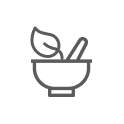We are exposed to dangerous pollutants, synthetic medications, chemicals, processed foods, alcohol, diseases, and so on in today's world. This may not appear to be a serious threat, but the truth is that toxins from these sources can seriously harm our health. Even if the body eventually adapts to the exposure, this does not indicate the toxins have left our bodies. Toxic substances gradually build up in our bodies over time, causing injuries. If this is the scenario, it is our responsibility to remove the toxins and keep the body healthy.
It might be surprising for us to understand how the body processes and eliminates the toxins out. The process of removal of toxins from the body is called detoxification. The liver is the major detoxifying organ. Toxins are either eliminated by urine or feces after they have been neutralized in the liver. Let us take a closer look at the liver and its detoxification system.
Functions of the liver

Metabolism, digestion, energy storage, and hormone production all rely on the liver (2). It is the organ capable of self-repair and renewal. As a result, causing more damage to the liver could lead to liver failure. Bile storage and concentration is one of the liver's key activities. Bile is a fluid that transports waste products from the liver. The liver is said to have 500 important activities. The most typical ones are listed below.
- Production of blood plasma proteins such as albumin and blood clotting factors.
- Synthesize cholesterol and fat-dissolving bile acids to emulsify the fat.
- Metabolism of fats, carbohydrates and proteins.
- Storage of excess glucose to glycogen. Glycogen can be later broken down to produce glucose for energy.
- Process hemoglobin and store iron.
- Conversion of toxic ammonia to urea and excretion in the urine.
- Blood detoxification activities like clearing drugs and other poisonous substances.
- Production of immune factors to fight against infections.
- Clearance of bilirubin, a yellow-orange pigment that is released from the breakdown of red blood cells. Accumulation of bilirubin can turn eyes and skin yellow (4).
Mechanism of liver detoxification: A natural way
Foreign substances (known as Xenobiotics) especially the toxins entering the body are usually lipid-soluble. It is difficult for the body to eliminate them in this form. As a result, they have the potential to build up in the body. In such cases, the liver performs a number of chemical reactions to remove them. Toxins, for example, go through a process called biotransformation in the liver after they've been ingested. During this process, they modify the biological activity of those toxins through phase 1 and phase 2 metabolisms. These reactions produce metabolites (end products) that are often more water-soluble than the originals and can be easily eliminated from the body (8).
Liver detoxification pathways
Phase 1: Provides first-line protection against toxins consumed. This pathway usually consists of enzymes (speed up reactions) that belong to the cytochrome p450 family (found in the liver). These enzymes neutralize toxic compounds and transform them into less dangerous ones. However, harmful by-products from the phase 1 reaction can sometimes accumulate and remain in the liver. If this occurs, they may damage our DNA and proteins. As a result, toxic by-products travel through phase 2 metabolism before being excreted (2).
Phase 2: Toxic by-products of the phase 1 pathway will be neutralized in this step. A series of chemical events known as conjugation occurs during this phase. The toxic by-products (usually not very water-soluble) are transformed into water-soluble compounds and sent out in urine or feces (2).
Alternative way: Detoxification through diet

Detox diets are very trendy these days. Detox diets are often used to eliminate toxins, boost health, and manage weight. It is considered to be an effective method for removing drug and alcohol toxins from the body and causing them to pass through the urine, feces, sweat, or sebum. The following are a few examples of detox diets:
- Total starvation fasting
- Fasting on juice
- Laxatives, diuretics, vitamins, minerals, and cleansing foods are all used.
Some of the popular liver cleansing diets include adding vegetarian, high-fiber, low-fat, dairy-free, minimally processed foods along with liver tonics. They are said to have advantages such as improved liver function, increased energy, toxin clearance, improved metabolism, immunological function, and the reduction of inflammation and other disorders. However, a number of detox diets lack scientific evidence. Moreover, extreme fasting can lead to protein, vitamin deficiencies, electrolyte imbalances, lactic acidosis and even death (6).
Grand Health’s® way
Are you concerned about overindulging in food and drinks during the holidays? Or are you waiting for a way to detoxify your body without depleting nutrients? HEPATON-S from Grand Health® is made up of scientifically proven medicinal herbs that can help protect the liver and improve its function. Each ingredient's advantages are described below.

Milk thistle: According to numerous scientific research, milk thistle and its extracts have been used as a liver tonic to treat a variety of liver illnesses, liver injuries, and liver toxin detoxification. A compound called silymarin is found in milk thistle extract. The active compound silibinin that makes up the majority of silymarin plays a crucial function in liver protection against toxins. Many clinical studies also proved that silibinin treatment is safe and effective against hepatic diseases when consumed in desired dosage (3).

Dandelion root has long been used in Asian countries such as China and India to treat hepatobiliary disorders. The plant contains vitamins, minerals, polysaccharides, bioflavonoids, and polyphenols, all of which can help with liver problems. These active molecules are antioxidants, which means they fight toxic oxidative compounds that harm the liver. It also acts as a diuretic, reduces bile flow disturbances, urinary obstructions, and provides hepatic protection (7).

Artichoke has long been used as a liver and gallbladder tonic. Cynarin, a naturally occurring bioactive component found in artichoke leaves, has been shown to have therapeutic properties. Numerous studies have shown that they provide hepatoprotection by fighting toxins and oxidative damage. Bile stimulation, liver protection, liver cleansing, and cholesterol reduction are some of the other important functions (1).
Choline and inositol are known to prevent abnormally high cholesterol and fat storage in the liver. It's also important for overall liver health, preventing liver damage, and preventing non-alcoholic fatty liver disease (5).
From this discussion, we know that all the ingredients found in Grand Health's® Hepaton-S will have a significant benefit in your upcoming detox plan. Use this product in combination with a healthy diet to detoxify the body. Visit https://www.grand-health.com/ for more details about the product.
References
- Aksu, Ö., & Altinterim, B. (2013). Hepatoprotective effects of artichoke (Cynara scolymus). Bilim ve Genclik Dergisi, 1(2), 44-49.
- Ask the Scientists. Liver Detoxification Pathways. https://askthescientists.com/qa/liver-detoxification-pathways/#toggle-id-1z. Accessed December 22, 2021.
- Hackett, E. S., Twedt, D. C., & Gustafson, D. L. (2013). Milk thistle and its derivative compounds: a review of opportunities for treatment of liver disease. Journal of veterinary internal medicine, 27(1), 10-16.
- John Hopkins Medicine. Liver: Anatomy and Functions. https://www.hopkinsmedicine.org/health/conditions-and-diseases/liver-anatomy-and-functions#:~:text=Functions%20of%20the%20liver,intestines%20passes%20through%20the%20liver. Accessed December 24, 2021.
- Kenney, J. L., & Carlberg, K. A. (1995). The effect of choline and myo-inositol on liver and carcass fat levels in aerobically trained rats. International journal of sports medicine, 16(02), 114-116.
- Klein, A. V., & Kiat, H. (2015). Detox diets for toxin elimination and weight management: a critical review of the evidence. Journal of human nutrition and dietetics, 28(6), 675-686.
- Mahboubi, M., & Mahboubi, M. (2020). Hepatoprotection by dandelion (Taraxacum officinale) and mechanisms. Asian Pacific Journal of Tropical Biomedicine, 10(1), 1.
- Timbrell, J. A., & Marrs, T. C. (2009). Biotransformation of xenobiotics. General, Applied and Systems Toxicology.











